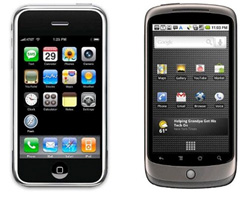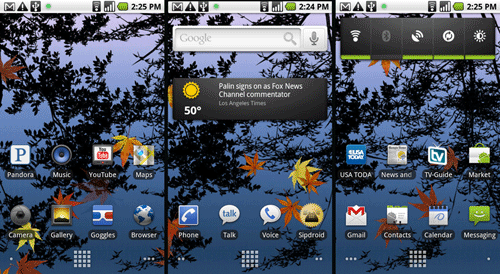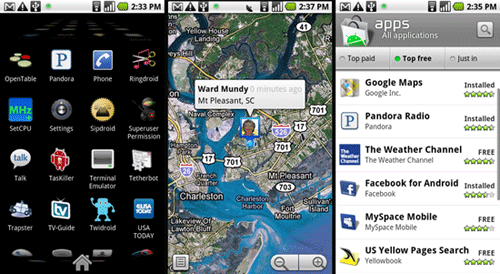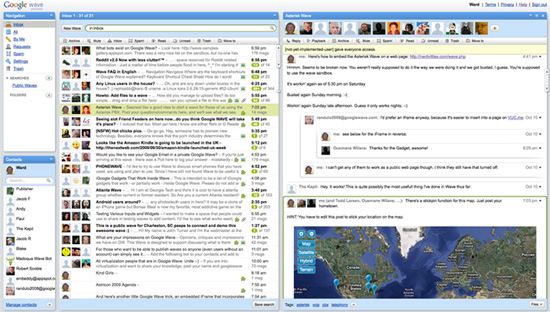Home » Technology » Video (Page 3)
Category Archives: Video
Introducing PogoPlug: Cloud Computing for $100 per Terabyte

Ever wished you could build and manage your own Cloud Computing Center with minimal cost and no recurring charges… ever? Well, today’s your lucky day.
It takes a lot to get us excited about a new product offering. But this one is a real winner! For under $130, Cloud Engines provides you your very own PogoPlug 2.0 device that connects to your router and shares up to four USB drives over the Internet. At today’s prices and ignoring sales tax, that means you can put eight terabytes of Cloud Storage on line for a one-time cost of about $100/terabyte. To give you a point of reference, Google will rent you the same space for $256/terabyte… per year. And Google is one of the least expensive Cloud Computing resources out there. Here’s the math for naysayers:
4 – WalMart1 2TB WD MyBook Drives @ $169 each = $676
1 – PogoPlug 2.0 Device @ $129 each = $129
ONE-TIME, NON-RECURRING COST: $805/8TB or $100/TB
For those that don’t need 8 terabytes, the 2 terabyte setup including the drive and PogoPlug device is still just over half the one-year rental rate of equivalent storage from Google. And, just to be clear, this isn’t merely a storage device (like Amazon S3) requiring downloads before the files can actually be used. PogoPlug’s software makes these USB drives an integral part of your Desktop just like any other attached storage devices. Think WebDAV! So it makes a perfect home for your music, movie, and photo collections. There also are loads of Open Source applications for PogoPlug for those that like to tinker. And you can use PogoPlug to keep synchronized backups of your important files.
Other Options. Be aware that for about $50 less, you can purchase the Seagate FreeAgent DockStar Network Adapter which includes a single year of PogoPlug Internet support. After that, it’s $30 annually. Translation: By the end of the second year, you’re better off with the PogoPlug. So the choice is a No-Brainer in our book. But, the fact that Seagate is also standing behind the PogoPlug design should make everyone sleep more soundly.
Deployment. After a one-minute, one-time setup over the Internet, you can securely access all of your USB drive resources via PogoPlug using either a web browser or one of several free desktop applications that are available for Windows, Mac OS X, Linux as well as Android phones, iPhones, and (earlier today) Blackberrys. And you get free support and a terrific forum. The device works flawlessly behind either a DSL or cable modem AND a NAT-based router so there are no firewall issues to address. Just enter the serial number on the bottom of your device when you access the PogoPlug web site, and configuration is automatic.
Uploading Files. One of PogoPlug’s slickest features is its automatic cataloging of files which are uploaded. Once uploaded, you can view your Music, Movies, and Pictures by simply clicking on one of the buttons. Photos are cataloged into directories by the month in which the photos were taken. Music is indexed by artist, album, and genre. In addition, music by artist, album and genre as well as photo albums can be shared by entering email addresses for those that can access the materials, by enabling public viewing (assuming you have legal rights to do so), or by sharing items using your Twitter, Facebook, and MySpace credentials. We’ve shared a photo album just to give you an idea of how this works. The security and logistical nuts and bolts all are managed by Cloud Engines’ servers. You can review and modify the materials you’re sharing by clicking on the Files I Share link in your browser. Finally you can automatically alert those with share privileges when folder content is updated. Very slick!
Give PogoPlug a try. By clicking on one of our links, you also help support the Nerd Vittles project. We think you’ll be as thrilled as we are with this terrific new creation. Enjoy!

Need help with Asterisk®? Visit the PBX in a Flash Forum.
Or Try the New, Free PBX in a Flash Conference Bridge.
whos.amung.us If you’re wondering what your fellow man is reading on Nerd Vittles these days, wonder no more. Visit our new whos.amung.us statistical web site and check out what’s happening. It’s a terrific resource both for us and for you.
Special Thanks to Our Generous Sponsors
FULL DISCLOSURE: ClearlyIP, Skyetel, Vitelity, DigitalOcean, Vultr, VoIP.ms, 3CX, Sangoma, TelecomsXchange and VitalPBX have provided financial support to Nerd Vittles and our open source projects through advertising, referral revenue, and/or merchandise. As an Amazon Associate and Best Buy Affiliate, we also earn from qualifying purchases. We’ve chosen these providers not the other way around. Our decisions are based upon their corporate reputation and the quality of their offerings and pricing. Our recommendations regarding technology are reached without regard to financial compensation except in situations in which comparable products at comparable pricing are available from multiple sources. In this limited case, we support our sponsors because our sponsors support us.
 BOGO Bonaza: Enjoy state-of-the-art VoIP service with a $10 credit and half-price SIP service on up to $500 of Skyetel trunking with free number porting when you fund your Skyetel account. No limits on number of simultaneous calls. Quadruple data center redundancy. $25 monthly minimum spend required. Tutorial and sign up details are here.
BOGO Bonaza: Enjoy state-of-the-art VoIP service with a $10 credit and half-price SIP service on up to $500 of Skyetel trunking with free number porting when you fund your Skyetel account. No limits on number of simultaneous calls. Quadruple data center redundancy. $25 monthly minimum spend required. Tutorial and sign up details are here.
 The lynchpin of Incredible PBX 2020 and beyond is ClearlyIP components which bring management of FreePBX modules and SIP phone integration to a level never before available with any other Asterisk distribution. And now you can configure and reconfigure your new Incredible PBX phones from the convenience of the Incredible PBX GUI.
The lynchpin of Incredible PBX 2020 and beyond is ClearlyIP components which bring management of FreePBX modules and SIP phone integration to a level never before available with any other Asterisk distribution. And now you can configure and reconfigure your new Incredible PBX phones from the convenience of the Incredible PBX GUI.
 VitalPBX is perhaps the fastest-growing PBX offering based upon Asterisk with an installed presence in more than 100 countries worldwide. VitalPBX has generously provided a customized White Label version of Incredible PBX tailored for use with all Incredible PBX and VitalPBX custom applications. Follow this link for a free test drive!
VitalPBX is perhaps the fastest-growing PBX offering based upon Asterisk with an installed presence in more than 100 countries worldwide. VitalPBX has generously provided a customized White Label version of Incredible PBX tailored for use with all Incredible PBX and VitalPBX custom applications. Follow this link for a free test drive!
 Special Thanks to Vitelity. Vitelity is now Voyant Communications and has halted new registrations for the time being. Our special thanks to Vitelity for their unwavering financial support over many years and to the many Nerd Vittles readers who continue to enjoy the benefits of their service offerings. We will keep everyone posted on further developments.
Special Thanks to Vitelity. Vitelity is now Voyant Communications and has halted new registrations for the time being. Our special thanks to Vitelity for their unwavering financial support over many years and to the many Nerd Vittles readers who continue to enjoy the benefits of their service offerings. We will keep everyone posted on further developments.
Some Recent Nerd Vittles Articles of Interest…
- The in-store pricing at WalMart is actually cheaper than on line for these particular drives. [↩]
Apple’s iPad: A Home Run for Education

We’ve been anything but a cheerleader for Apple lately. And that applies in spades to the iPad. If you follow us on Twitter, here’s a sampling of our comments since the iPad was introduced last week.
The Computer Illiterate’s Dream Machine: Meet the iPad. Thinking you’ll slip your existing AT&T or T-Mobile SIM into Apple’s new iPad? Think again.
iPad: The Good http://tr.im/ipadg, The Bad http://tr.im/ipadb, and The Ugly http://tr.im/ipadu
iPad: Uh, but wait, No Camera http://tr.im/ipadc, No Flash http://tr.im/ipadf, No Multitasking http://tr.im/ipadm. No thanks.
Funny: Hitler’s take on the iPad. http://tr.im/ipadah
Why Apple Doesn’t Want Flash on the iPhone and iPad? It Finally Makes $ense. http://tr.im/theflash
The Vote That Really Matters: A 16-year-old’s view of Apple’s iPad: iFail http://tr.im/ipad16 (via @scobleizer)
Michael Dell demos what the iPad coulda/woulda/shoulda been. http://bit.ly/czYPww (via @engadget) #android Mini5
iPad Web Surfing: Here’s what the future holds. http://tr.im/noflash (via @gadgetweb) #surfsdown
RT @cultofmac: "Pundits On The iPad’s Closed System: It’s Doom For PCs, No It’s Great" http://bit.ly/cpFV4v
Apple iPad Micro SIM guarantees that you’ll be paying for two wireless data plans instead of one. http://bit.ly/bYipZP
Funny: iPad v. A Rock http://bit.ly/b50XP2 (via @TechCrunch)
RT @TechmemeFH: Apple reinventing file access, wireless sharing for iPad (Prince McLean/AppleInsider) http://bit.ly/awHJzG
Today’s Math Lesson: Hulu + Flash = Free Internet Movies. iPad – Flash = Megabucks for Apple from iTunes Movie Store sales
RT @dcagle: The library of the future, courtesy of the iPad http://bit.ly/bFvDAE #apple #toon
So what’s with the headline? Have we changed our mind? Well, no. It’s a lousy machine for us and for anyone above the age of puberty. But sometimes you need to look beyond the forest to find the nugget in the trees. And we’ve found the iPad’s Sweet Spot: It’s Lower School Education, Stupid!
For all the reasons that make the iPad an undesirable computing device for adults, it turns out these same qualities make it an almost perfect learning platform for young children, ages 3 to 12. In fact, we think it has the potential to revolutionize preschool and elementary education.

For openers, we can all probably agree that the key to a good education is good teachers. And that’s especially true when it comes to computer education. The problem, of course, is that teachers of young children don’t have the time or the resources to keep up with computer technology because they’re so busy doing all the things that parents should actually be doing to raise their kids. So, other than turning kids loose with a computer game, PCs have been all but worthless in lower school education because the teachers never had time to master the devices themselves. The iPad fixes that because of its incredibly simple learning curve. Any teacher can master the richness of the iPad interface in an hour. And it turns out that’s probably true for young children as well. If you don’t believe it, hand a kid your iPhone and come back in an hour.
A computer is important in early education because it’s much more patient and individually focused than any teacher ever could be. A computer doesn’t care how many times it takes a kid to master a specific topic. And, for young children, they need the repetition at their own pace until they actually get it. The iPad can handle all of these repetitive tasks while freeing the teacher up for observation and pinpoint coaching. So it levels the playing field by getting the "slow learners" up to speed without the usual frustrations of dealing with kids with different levels of comprehension. And the iPad accomplishes this while making education fun instead of frustrating!
Young kids learn with their hands. Walk in any lower school classroom if you don’t believe it. The iPad is a hands-on device. You use your hands literally for everything: a mouse, a navigation instrument, a drawing tool, and for writing and typing. So it’s a natural for kids, just like a hammer.

If you’ve ever visited a Montessori school, you’ll come away appreciating how critically important group collaboration can be to early education. Working in teams enhances learning in so many ways. The iPad is a natural collaboration tool. It can be used to encourage kids to jointly develop rich multimedia reports pulling from the web, their textbooks, images, and their classmates. iWork for iPad at $9.95 per application is the perfect development tool. And, as Steve Jobs demonstrated, the iPad makes a perfect presentation tool. Teaching kids to stand in front of their peers and tell a story is probably the single most important thing kids can learn in elementary education. You learn a lot more teaching others than you’ll ever learn as a student. Most of today’s adults never got it… nor did they have the opportunity that the iPad presents.
We could write a book about the advantages which would flow from getting rid of hardback books. Not only would it save trees and natural resources, but it also could turn books into living, breathing educational tools with rich multimedia presentations instead of static images. Instead of kids lugging around a backpack full of textbooks which will be obsolete in a year or two, they could carry an iPad with all of their learning tools, their schedules, their homework, and their presentations. Think about the possibilities, and you’ll come to appreciate why the iPad really could revolutionize education as we know it. We hope so. Go talk to the educators in your community and get them excited about this Golden Opportunity. You’re only young once!

For a well-balanced, thought-provoking review of the iPad, head over to emergent by design.
We’ll leave you with Neil Curtis’ 3-minute, adjective-laced version of Steve Jobs’ iPad Introduction. And, just in case you missed the Grammy Awards last night, there was an iPad Presentation there as well. Funny stuff!
Some Recent Nerd Vittles Articles of Interest…
Choosing the World’s Best Mobile Phone… Again!
 Up until now, we’ve resisted the temptation to wade into the iPhone vs. Nexus One battle. And there have been many thought-provoking contributions on both sides of the discussion. Our take on it is that, for many folks, it’s now come down to the Ford vs. Chevy debate. We know lots of Ford enthusiasts that would never set foot in a GM vehicle. And vice versa.
Up until now, we’ve resisted the temptation to wade into the iPhone vs. Nexus One battle. And there have been many thought-provoking contributions on both sides of the discussion. Our take on it is that, for many folks, it’s now come down to the Ford vs. Chevy debate. We know lots of Ford enthusiasts that would never set foot in a GM vehicle. And vice versa.
In the cellphone world, there are some differences between Apple and Google philosophically that you really don’t see in choosing between Ford and Chevy. If you’re looking for a cellphone that just works, that requires little involvement on your part, and that basically functions as a phone, a music player, and a handheld game device, then you’ll love the iPhone. Apple controls the entire user experience end-to-end, and they’ve gotten it just about right after three years of evolutionary development. If you’re looking for a cellphone that functions more as a mobile office, then the choice comes down to Blackberry vs. Nexus One at least in our book. The Blackberry still is the hands-down winner if your business runs on Microsoft Exchange although the Nexus One performs admirably. For everyone else, the Nexus One is your baby. That’s where we are today. But what about next year, and…
It’s Integration, Stupid! Unless you’ve been living under a rock, Cloud Computing should not be a new concept. The whole corporate world is moving there. Why? Because it’s too damn expensive to manage the complexities of modern data processing technology in house. And when it comes to Cloud Computing, there’s no one better at it than Google. The tight integration of email, messaging, voice communications, directories, calendaring/scheduling, and maps in the Google universe is legendary. And Google is damn close to Microsoft on the document preparation and spreadsheet front. Google’s search technology is simply the icing on the cake. But what icing! It ties all of these components together in a way that others only Bing about.
What the Nexus One brings to the table is a mobile computing platform that is fully capable of taking advantage of all of Google’s integration strengths. Email is always synchronized with your Gmail account. Your Address Book is always synchronized with your Google Address book. Your calendar is always synchronized with your Google Calendar and those of your coworkers. Your phone rings on your Nexus One at the same time it rings in your office or home. And your outbound calls, including your CallerID, can be processed just as if you were placing the same calls from your office or home. Simple, isn’t it? Can Apple do the same thing? To some extent, certainly. But the Apple MobileMe sync technology is archaic compared to the Google model. With Apple you’re synchronizing Address Books and Calendars from Apple-only desktop machines to a central server (for a fee) on a scheduled basis. That leaves 90% of corporate America out of the loop. With Google, there is only one Address Book and Calendar, and they’re both already stored in the Cloud. So you don’t have the endless problems associated with keeping a dozen or a hundred or thousands of users’ information in sync.

Long Live the Soup Nazi. For Seinfeld fans, no one can touch the Draconian deeds of the Soup Nazi. But Apple comes close: pushing out updates that reportedly bricked the iPhones of users that sought a bit more freedom in their software choices, telling the FCC that unlocked iPhones threaten the security of the national cellphone network, ruling the Apple Store with an iron fist. This is not acceptable corporate behavior in our book. For the average cellphone user, this conduct may not matter, but it should. The choice really comes down to spending your dollars with a company that fosters and encourages open source development versus a company that treats you as if you’re too dumb to know what’s good for you.

Our Pick: The Nexus One. We’ll leave you with our Baker’s Dozen reasons for choosing the Nexus One over the iPhone. YMMV! For the best and most balanced technical review to date, visit Ars Technica.
1. Google Apps Integration (see above)
2. Navigation integrated with Voice & Google Maps (video)
3. Phone-wide Speech-to-Text Voice Integration
4. Multitasking and Recent App Switcher Button
5. Back Button to non-destructively back out of anything
6. One-Touch App Directory plus 5 Custom Screens
7. Goggles & Dolphin Multi-Touch Browser
8. SIP and Google Voice integration with WiFi and Cell Nets
9. Intuitive store without corporate content control
10. Unlocked phone, easily rooted, Cyanogen
11. Replaceable battery
12. Expandable storage
13. Flash
In the immortal words of Bernie Mac, "Whatcha gonna do, America?"

Need help with Asterisk®? Visit the PBX in a Flash Forum.
Or Try the New, Free PBX in a Flash Conference Bridge.
whos.amung.us If you’re wondering what your fellow man is reading on Nerd Vittles these days, wonder no more. Visit our new whos.amung.us statistical web site and check out what’s happening. It’s a terrific resource both for us and for you.
Special Thanks to Our Generous Sponsors
FULL DISCLOSURE: ClearlyIP, Skyetel, Vitelity, DigitalOcean, Vultr, VoIP.ms, 3CX, Sangoma, TelecomsXchange and VitalPBX have provided financial support to Nerd Vittles and our open source projects through advertising, referral revenue, and/or merchandise. As an Amazon Associate and Best Buy Affiliate, we also earn from qualifying purchases. We’ve chosen these providers not the other way around. Our decisions are based upon their corporate reputation and the quality of their offerings and pricing. Our recommendations regarding technology are reached without regard to financial compensation except in situations in which comparable products at comparable pricing are available from multiple sources. In this limited case, we support our sponsors because our sponsors support us.
 BOGO Bonaza: Enjoy state-of-the-art VoIP service with a $10 credit and half-price SIP service on up to $500 of Skyetel trunking with free number porting when you fund your Skyetel account. No limits on number of simultaneous calls. Quadruple data center redundancy. $25 monthly minimum spend required. Tutorial and sign up details are here.
BOGO Bonaza: Enjoy state-of-the-art VoIP service with a $10 credit and half-price SIP service on up to $500 of Skyetel trunking with free number porting when you fund your Skyetel account. No limits on number of simultaneous calls. Quadruple data center redundancy. $25 monthly minimum spend required. Tutorial and sign up details are here.
 The lynchpin of Incredible PBX 2020 and beyond is ClearlyIP components which bring management of FreePBX modules and SIP phone integration to a level never before available with any other Asterisk distribution. And now you can configure and reconfigure your new Incredible PBX phones from the convenience of the Incredible PBX GUI.
The lynchpin of Incredible PBX 2020 and beyond is ClearlyIP components which bring management of FreePBX modules and SIP phone integration to a level never before available with any other Asterisk distribution. And now you can configure and reconfigure your new Incredible PBX phones from the convenience of the Incredible PBX GUI.
 VitalPBX is perhaps the fastest-growing PBX offering based upon Asterisk with an installed presence in more than 100 countries worldwide. VitalPBX has generously provided a customized White Label version of Incredible PBX tailored for use with all Incredible PBX and VitalPBX custom applications. Follow this link for a free test drive!
VitalPBX is perhaps the fastest-growing PBX offering based upon Asterisk with an installed presence in more than 100 countries worldwide. VitalPBX has generously provided a customized White Label version of Incredible PBX tailored for use with all Incredible PBX and VitalPBX custom applications. Follow this link for a free test drive!
 Special Thanks to Vitelity. Vitelity is now Voyant Communications and has halted new registrations for the time being. Our special thanks to Vitelity for their unwavering financial support over many years and to the many Nerd Vittles readers who continue to enjoy the benefits of their service offerings. We will keep everyone posted on further developments.
Special Thanks to Vitelity. Vitelity is now Voyant Communications and has halted new registrations for the time being. Our special thanks to Vitelity for their unwavering financial support over many years and to the many Nerd Vittles readers who continue to enjoy the benefits of their service offerings. We will keep everyone posted on further developments.
Some Recent Nerd Vittles Articles of Interest…
Free At Last: The Emancipation of the Apple TV
We’ve never quite forgiven Apple1 for bricking some of the original iPhones because some owners chose to jailbreak their private property to learn how it worked or to add additional functionality. It may turn out to be Steve Jobs’ billion dollar blunder! The stunt was especially egregious when one considers that both the iPhone and much of Mac OS X are based upon open source software for which Apple didn’t pay a nickel. Apple certainly added a pretty wrapper, but the internals of both the iPhone and Mac OS X contain loads of pure open source code including dozens of Mach 3.0 and FreeBSD 5 applications. Destroying people’s cellular phones for accessing soft- ware that was licensed to Apple as open source code just doesn’t pass the smell test.

Thus it was with mixed emotions that we unwrapped our Apple TV during Christmas 2007. Like the iPhone, it was locked up tighter than a drum even though the internals of the product read like a Who’s Who of the Open Source Movement: awk, bzip, cut, grep, find, ftp, finger, gzip, more, nano, openssl, perl, sed, tail, tar, touch, uname, whois, zip, and on and on. In fact, Mac OS X arguably is a better Linux than Linux. Suffice it to say, we read numerous articles outlining the lengths to which some talented users were going to unlock their Apple TVs. The process required disassembly of the unit, removal of the hard disk, and then a tedious unlocking scenario that was akin to breaking into Fort Knox. We chose to leave our Apple TV in its shrink wrap.
So what’s wrong with the Apple TV? Well, nothing… if you don’t mind paying Apple over and over again to reacquire media content which you already have licensed and if you don’t mind jumping through the iTunes hoops to transfer that content to a device which is perfectly capable of being self-sufficient. Let’s see. $1.99 to watch a TV show or play a music video that’s already sitting on your TIVO machine or that’s already freely (and legally) available from numerous sources on the Internet. Apple has added YouTube access, but the design really limits you to the most popular content. That makes it unsuitable (or worse) for anyone under the age of 13… or over the age of about 25. 🙄
Fast forward to 2009, and we decided it was time to take another look at the Apple TV landscape. WOW! What a difference a year makes. You now can create a bootable USB flash drive in a couple minutes, plug it into your Apple TV, and have a perfectly functioning, (true) open source appliance with DIVX and AVI support in less than 15 minutes. The FrontRow-enhanced Apple TV provides access to virtually all media content in every format imaginable with incredibly slick user interfaces thanks to the XBMC Media Center, Boxee Social Media Center, Nito TV, and Hulu. Most were originally designed for Microsoft’s Xbox. Uploads and downloads of media content can be performed using either your Apple TV controller and a television, or a web browser, or SAMBA networking, or SSH. So thanks to a resourceful bunch of talented, open source developers, we finally have an Apple TV worth owning that also happens to be fun to use. Incidentally, this whole metamorphosis can be accomplished without damaging the Apple TV’s existing user interface or its out-of-the-box functionality… at least until the next update from Apple. 🙂
So proceed at your own risk!

Freeing Your Apple TV. Since October, 2008, the emancipation of the Apple TV has become a simple, 5-minute exercise. What you’ll need to get started is an Apple TV2 with version 2 software, a 1GB USB Flash Drive, and ATVUSB-creator which is free. The drill here is to create a bootable flash drive that can be used to reboot the Apple TV and transform its closed and proprietary shell into an open source platform. The preferred machine for creating your bootable flash drive is a Mac running Tiger or Leopard although a Windows XP/Vista solution is also available now. The only precaution we would add is to unplug all of the USB drives connected to your PC before creating the bootable flash drive. Then you won’t accidentally reformat the wrong USB drive. The one-minute CNET tutorial is here. A better one is here.

Once you have your bootable USB flash drive in hand, unplug your Apple TV and plug the USB drive into the unit. Now connect your Apple TV to a television. Power up your Apple TV and marvel at the installation process which takes under a minute. Whatever you do, don’t boot your Apple TV with the flash drive more than once! When the install completes, you should see a message indicating that your Apple TV can be accessed with SSH within a few minutes at frontrow@appletv.local. The password is frontrow. The IP address for your Apple TV also can be used for SSH access as well. Remove the flash drive and reboot. You’ll see a new menu option for XBMC/Boxee. Just follow the menu items to install both applications. After another reboot, you’ll be all set. Click on the CNET video above to watch a demo.
After installing the apps, launch and then configure XBMC. If you get an error that reads "Cannot launch XBMC/Boxee from path," it means you forgot to install the software through your TV menu. If you enable the web interface, you’ll be able to go to any browser on your LAN and manage XBMC through the following link using the IP address of your Apple TV: http://192.168.0.180:8080. For complete documentation, check out the XBMC Wiki.
Before you can use Boxee, you’ll need to visit their web site and sign up for an account. A tutorial on the application is available at UberGizmo. As luck would have it, this application only became publicly available in Alpha last week so we’re just in time. Don’t sweat the Alpha status too much, it previously ran on the XBox platform as well as Windows, Macs, and Linux. There’s social networking support via Twitter, FriendFeed, Tumblr, and NetFlix. While it’s running on your Apple TV, you can access the interface remotely with a browser from anywhere on your LAN at http://ipaddress:8800 assuming you have enabled the web server interface.

Hulu is another terrific resource for movies, TV shows and music videos. It is available through Boxee. There are a few ads but not many. For a lot of the movies, you’ll also need to set yourself up an account there and configure your uncrippled Apple TV accordingly.
 But What About Asterisk®? We knew someone would ask. Sure. An Asterisk for Mac solution should work on the Apple TV if you don’t plan to use it as a media center. For best results, compile everything on a separate Tiger Mac, and then move it over. Keep in mind that the device is limited to 256MB of RAM so simultaneously using the Apple TV as both an Asterisk PBX and a media center more than likely will cause unacceptable performance degradation in both your phone calls and your music and video streams. Someday perhaps we’ll give it a try. In the meantime, enjoy your new open source media center!
But What About Asterisk®? We knew someone would ask. Sure. An Asterisk for Mac solution should work on the Apple TV if you don’t plan to use it as a media center. For best results, compile everything on a separate Tiger Mac, and then move it over. Keep in mind that the device is limited to 256MB of RAM so simultaneously using the Apple TV as both an Asterisk PBX and a media center more than likely will cause unacceptable performance degradation in both your phone calls and your music and video streams. Someday perhaps we’ll give it a try. In the meantime, enjoy your new open source media center!
 Want a Bootable PBX in a Flash Drive? Next week to celebrate the beginning of Nerd Vittles’ Fifth Year, we’ll be introducing our bootable USB flash installer for PBX in a Flash with all of the goodies in the VPN in a Flash system featured a few weeks ago on Nerd Vittles. You can build a complete turnkey system using almost any current generation PC with a SATA drive and our flash installer in less than 15 minutes!
Want a Bootable PBX in a Flash Drive? Next week to celebrate the beginning of Nerd Vittles’ Fifth Year, we’ll be introducing our bootable USB flash installer for PBX in a Flash with all of the goodies in the VPN in a Flash system featured a few weeks ago on Nerd Vittles. You can build a complete turnkey system using almost any current generation PC with a SATA drive and our flash installer in less than 15 minutes!
If you’d like to put your name in the hat for a chance to win a free one delivered to your door, just post a comment at this link with your best PBX in a Flash story.3
Be sure to include your real email address which will not be posted. The winner will be chosen by drawing an email address out of a hat (the old fashioned way!) from all of the comments posted over the next couple weeks. Good luck to everyone!
Special Thanks to Our Generous Sponsors
FULL DISCLOSURE: ClearlyIP, Skyetel, Vitelity, DigitalOcean, Vultr, VoIP.ms, 3CX, Sangoma, TelecomsXchange and VitalPBX have provided financial support to Nerd Vittles and our open source projects through advertising, referral revenue, and/or merchandise. As an Amazon Associate and Best Buy Affiliate, we also earn from qualifying purchases. We’ve chosen these providers not the other way around. Our decisions are based upon their corporate reputation and the quality of their offerings and pricing. Our recommendations regarding technology are reached without regard to financial compensation except in situations in which comparable products at comparable pricing are available from multiple sources. In this limited case, we support our sponsors because our sponsors support us.
 BOGO Bonaza: Enjoy state-of-the-art VoIP service with a $10 credit and half-price SIP service on up to $500 of Skyetel trunking with free number porting when you fund your Skyetel account. No limits on number of simultaneous calls. Quadruple data center redundancy. $25 monthly minimum spend required. Tutorial and sign up details are here.
BOGO Bonaza: Enjoy state-of-the-art VoIP service with a $10 credit and half-price SIP service on up to $500 of Skyetel trunking with free number porting when you fund your Skyetel account. No limits on number of simultaneous calls. Quadruple data center redundancy. $25 monthly minimum spend required. Tutorial and sign up details are here.
 The lynchpin of Incredible PBX 2020 and beyond is ClearlyIP components which bring management of FreePBX modules and SIP phone integration to a level never before available with any other Asterisk distribution. And now you can configure and reconfigure your new Incredible PBX phones from the convenience of the Incredible PBX GUI.
The lynchpin of Incredible PBX 2020 and beyond is ClearlyIP components which bring management of FreePBX modules and SIP phone integration to a level never before available with any other Asterisk distribution. And now you can configure and reconfigure your new Incredible PBX phones from the convenience of the Incredible PBX GUI.
 VitalPBX is perhaps the fastest-growing PBX offering based upon Asterisk with an installed presence in more than 100 countries worldwide. VitalPBX has generously provided a customized White Label version of Incredible PBX tailored for use with all Incredible PBX and VitalPBX custom applications. Follow this link for a free test drive!
VitalPBX is perhaps the fastest-growing PBX offering based upon Asterisk with an installed presence in more than 100 countries worldwide. VitalPBX has generously provided a customized White Label version of Incredible PBX tailored for use with all Incredible PBX and VitalPBX custom applications. Follow this link for a free test drive!
 Special Thanks to Vitelity. Vitelity is now Voyant Communications and has halted new registrations for the time being. Our special thanks to Vitelity for their unwavering financial support over many years and to the many Nerd Vittles readers who continue to enjoy the benefits of their service offerings. We will keep everyone posted on further developments.
Special Thanks to Vitelity. Vitelity is now Voyant Communications and has halted new registrations for the time being. Our special thanks to Vitelity for their unwavering financial support over many years and to the many Nerd Vittles readers who continue to enjoy the benefits of their service offerings. We will keep everyone posted on further developments.
Some Recent Nerd Vittles Articles of Interest…
- Disgruntled customers reportedly have filed over a billion dollars’ worth of lawsuits over their bricked iPhones claiming Apple did it intentionally. Great PR move there, Steve! [↩]
- The Apple TV actually runs a modified version of Tiger (aka Mac OS X 10.4). [↩]
- This offer does not extend to those in jurisdictions in which our offer or your participation may be regulated or prohibited by statute or regulation. [↩]
Manly Man Alert: A Valentine’s "Gift With A Plug" That Won’t Get You Killed
 We’ve been a big fan of the Ceiva digital picture frames since they were first introduced several years back. In fact, all of my daughters’ grandmothers have one and love them. The beauty of the devices is that you can upload photos to the Ceiva web site and update one or many devices whenever you choose. The drawbacks are the monthly subscription fee per device (which now costs as much per frame as dial-up Internet service) and low resolution displays (640×480) which are adequate but nothing special to look at. The devices hold a maximum of 20 pictures or a customized weather or stock report. If you want to display the pictures perfectly on the Ceiva, then the images need to be converted to 640×480 before you upload them. When grandma is hundreds of miles away, however, there is no better gift on the planet if there are young grandchildren that change almost every day. And you can provide special passwords to numerous people to allow them to share photos with grandma as well.
We’ve been a big fan of the Ceiva digital picture frames since they were first introduced several years back. In fact, all of my daughters’ grandmothers have one and love them. The beauty of the devices is that you can upload photos to the Ceiva web site and update one or many devices whenever you choose. The drawbacks are the monthly subscription fee per device (which now costs as much per frame as dial-up Internet service) and low resolution displays (640×480) which are adequate but nothing special to look at. The devices hold a maximum of 20 pictures or a customized weather or stock report. If you want to display the pictures perfectly on the Ceiva, then the images need to be converted to 640×480 before you upload them. When grandma is hundreds of miles away, however, there is no better gift on the planet if there are young grandchildren that change almost every day. And you can provide special passwords to numerous people to allow them to share photos with grandma as well.
Today’s column, however, isn’t just about what’s good for grandma. It’s about a brand new digital picture frame for your significant other. The frame can handle a CompactFlash, SD, MMC, or MemoryStick card but has no Internet connectivity. In short, you’ll need physical access to this device to load it with pictures. The tradeoff is its resolution which is nothing short of incredible. In addition to being powered by an AC adapter, the unit also can operate on its internal battery for about an hour at a time, just long enough to pass it around on Valentine’s Day with a customized slide show of about 50 pictures. The actual LCD image is 4″ x 6″ and can be oriented either vertically or horizontally. Unlike similar, high quality frames of years past which sold for several thousand dollars, this one, the Philips Digital Photo Display, is downright reasonable with a suggested retail price of $299 which is exactly what it costs at The Sharper Image, the only retailer with the product in stock this past Christmas. There’s a link on Philips’ web site to check for other retailers, and there may be some that actually have the unit by now.
The way the system works is that you load several dozen of your favorite photos on your preferred memory card. Then plug the card into the frame. You’ll get a listing of all the pictures that are "suitable" for use with the frame. Some low-res photos and super high-res photos get rejected. Otherwise, you click a button on the back of the frame to choose the pictures you want to upload to the frame’s internal memory. Then you click the OK button and let the frame do its thing. It will convert every photo to fit perfectly on the frame regardless of its original dimensions. Once all the pictures are loaded, you simply remove the memory card and set the display to play back your pictures either randomly or sequentially in a slide show. Image switching and image orientation both are based on a variety of settings from which you can choose. You also can set an ON and OFF time for the frame each day. A USB cable also is included for connecting the unit to your PC or Mac.
Bottom Line: If you have a digital camera, you need one of these … maybe more. We rate this frame a must-have for those that are serious about photography and want a high quality, easy to use device for displaying several dozen photos in your home or office. It’s also the perfect Valentine’s gift, and you’ve still got almost a week to find one so get busy! If you spend a little time loading it up with pictures before the Big Day, this may be the first "gift with a plug" that doesn’t get you a black eye from your spouse. YMMV.

The Best of Santa: Introducing the Nokia 770 Internet Tablet.everything
 Ever wished someone would come up with a portable Wi-Fi and Bluetooth-enabled device with a web browser, email client, news reader, PDF viewer, streaming audio and video players, and a SIP phone all rolled into a Linux-based, Internet Tablet? Well, it’s here with the exception of the SIP phone which is scheduled for early 2006. It’s about the size of your hand. And, if games are your thing, there’s Chess, Mahjong, Marbles, and virtually any other game that has been ported to the ARM version of Slackware including clones of Tetris, IceBreaker, Minesweeper, Doom, and on and on.
Ever wished someone would come up with a portable Wi-Fi and Bluetooth-enabled device with a web browser, email client, news reader, PDF viewer, streaming audio and video players, and a SIP phone all rolled into a Linux-based, Internet Tablet? Well, it’s here with the exception of the SIP phone which is scheduled for early 2006. It’s about the size of your hand. And, if games are your thing, there’s Chess, Mahjong, Marbles, and virtually any other game that has been ported to the ARM version of Slackware including clones of Tetris, IceBreaker, Minesweeper, Doom, and on and on.
The good folks at Nokia (yep, the cellphone people) finally have shipped the Nokia 770. And what a toy it is: the perfect addition to every commuter train ride or Starbucks visit. You may never travel with a notebook PC again. By loading an X terminal emulator, you have a Linux command prompt that will let you load and install virtually any Debian application on the planet: ssh, rsync, Office-compatible apps, VNC, NFS, GAIM IM, SQLite, and yes, someone has even ported the Asterisk® PBX to the 770. For those with a compatible Bluetooth cellphone, you can use your phone as your 770’s Internet link when there’s no Wi-Fi access point in your vicinity. It’s a bit quirky, but it does work with both CDMA and GSM Treo 650’s. And the best news of all: the Nokia 770 sports a high-res color screen that will have you believing you’re still sitting at your desktop PC. Best price: $349 at CompUSA this week.
If you want to learn more, start at Nokia’s site for Flash-based demonstrations (which play equally well on the Nokia 770 incidentally). Then visit the Nokia-supported development site, maemo.org, and have a look at the long list of apps which already are available and are free to download. And then head over to Vidar Madsen’s and Russell Beattie’s sites to see what’s new in the Nokia 770 universe. And by all means pay a visit to Ari Jaaksi, whose Open Source team at Nokia made it all possible. For a more detailed review, visit this ArsTechnica link. Still have questions? Check out the Internet Tablet Talk Forums.

ISP-In-A-Box: The Final Chapter (P2P from A to Z)
In the beginning, there was Napster. And then there wasn’t. Then, from our friends at AOL, sprang Gnutella. And Gnutella begot Limewire. Now you can download BitTorrent for free from Apple, and Napster’s once again offering unlimited song downloads … as long as your $15 check clears each month for as long as you both shall live. What’s wrong with this picture? Well, that’s for the Supreme Court to know, and you to find out. In the meantime, while the Supreme Court is deciding the future of peer-to-peer (P2P) networks in the United States, it seemed like a good time to once again propose a fresh approach to the music sharing problem and to briefly review some of the P2P software options which are available at least today on the Mac platform.
It’s the M-Chip, Stupid! We won’t wade into the legal thicket of how you should use P2P tools other than to note, as we have in the past, that Congress has really dropped the copyright ball by refusing to consider creative solutions to the music and movie downloading problems and instead opting to rubber-stamp legislation reportedly drafted by the folks they should be regulating. It would be so easy to add $100 to the price of every music or video player and make all of this litigation go away. Before you say $100 is too cheap, just consider how many music and video players you have in your home and cars and how long they typically last before you buy new ones. The tally for our family is close to 20 devices, but don’t tell your burglar friends! Think of my proposal as a reverse V-Chip for music. Let’s call it the M-Chip. Instead of locking you out of content as the V-Chip does, the M-Chip would let you in. Pay your $100 and the M-Chip would enable your music player to play any music (encrypted or not) that you can get your hands on … legally! M-Chip proceeds would go to the record companies and musicians. And, down the road when every music player had an M-Chip, why would we need encryption any longer other than to make the music moguls sleep better? The only drawback I see to this approach is the poor lawyers. What would all of them do if the ‘music problem’ just went away?
If you want to read more, here’s a link to our previous discussion of this topic. And the Electronic Frontier Foundation has a great site that explains everything which is at stake in the pending Supreme Court case. We’ll assume that the Supreme Court will do the right thing and allow P2P networking technology to coexist with the recording industry and the movie studios. But who knows? Perhaps the next big public works project can be building enough jails to house the million plus Limewire users who are on line most of every day and night. Or, we could borrow a page from the Chairman of the Senate Judiciary Committee, Senator Orrin Hatch. He believes we should blow up the computers of people who download music illegally. Isn’t it nice to finally see one of our elected representatives thinking creatively? We’d like to believe he was just frustrated by the difficulty of the copyright problem. Otherwise, just think what he might do to you for stealing something that costs more than 99¢. Death row, here we come. Three songs, and you’re out … for good.
The real problem with all the legal mess, and it is most assuredly a mess which is only getting worse, is the adverse effect it is having on an entire generation of Americans who see nothing really wrong with committing felonies before breakfast each morning… assuming they’re up at that time of the day. And, of course, there’s the chilling effect it is having on enhancement and use of an incredibly versatile and creative technology: P2P networking. Killing off technology pioneers to deter music pirates is not unlike biting off one’s nose to spite your face. In short, it’s a great way to irreparably damage the innovative spirit which has made the United States a creative force since the days of Thomas Edison. Write your representatives in Congress and urge them to look at this issue responsibly … as if their children’s futures and respect for the American legal system were at stake. They are. End of sermon.
 If P2P networking is your thing, then there is no finer platform for it than the Mac. Why? That’s an easy one. The P2P tools that have been written for the Mac platform don’t include the Spyware and Trojan Horse features which you’ll find in almost all of the offerings for the Windows platform. Just try to delete a P2P application from a Windows machine, and you’ll understand what we’re talking about. The real beauty of P2P technology is that it provides an IP solution for sharing files amongst various types of computers worldwide, something we’ve all become accustomed to using local area networks. In addition to many other companies, IBM has devoted enormous resources to exploration of P2P technology for business use.
If P2P networking is your thing, then there is no finer platform for it than the Mac. Why? That’s an easy one. The P2P tools that have been written for the Mac platform don’t include the Spyware and Trojan Horse features which you’ll find in almost all of the offerings for the Windows platform. Just try to delete a P2P application from a Windows machine, and you’ll understand what we’re talking about. The real beauty of P2P technology is that it provides an IP solution for sharing files amongst various types of computers worldwide, something we’ve all become accustomed to using local area networks. In addition to many other companies, IBM has devoted enormous resources to exploration of P2P technology for business use.
Two very different P2P technologies provide excellent results on the Mac platform. The traditional P2P solution is Limewire which includes free (with ads) and Pro versions. A better Limewire solution and the reason some folks have actually switched to the Mac platform is a product called Acquisition. It has perhaps the best user interface ever written for Mac OS X, and at $16.99 for a single-user license, it won’t break the bank either. Installation is a breeze. Download the software from here and drag the Acquisition icon to your Applications folder. Run the Application and choose Preferences to set your default download and upload folders, to turn on iTunes integration, and to specify the number of simultaneous connections you wish to support. Now enter a search term and presto! And, yes, keep in mind that downloading or uploading copyrighted material is against the law … at least in the USA. But, if all you want to do is download music, perhaps it’s time you planned a vacation to Canada with your Mac mini or Powerbook, but you’d better hurry if current news articles are to be believed.
The other great P2P solution for the Mac platform is BitTorrent which is available for free download from Apple’s web site. Go figure. Once you download the software, just drag the application to your Applications folder and start it up. Now use Google to search for BitTorrent content. HINT: The files always end with an extension of .torrent. The same copyright warnings (as above) apply, and Big Brother is probably a BitTorrent user himself. Everything you ever wanted to know about BitTorrent is available in their FAQ or Brian’s FAQ and Guide.
Finally, while we’re on the subject of music downloads, there’s been lots of buzz recently about a Russian web site (allofmp3.com) which offers music downloads for about a penny a minute, slightly cheaper than iTunes. But, is it legal? With our usual disclaimer that we’re not in the business of providing legal advice here, we can point you to some sites that discuss the issue. FadMine seems to think it’s OK. Moscow prosecutors also gave allofmp3.com the green light, at least inside Russia. And then there’s at least one California lawyer that thinks it’s not. But see this piece in the Tech Law Advisor. In the Americanized words of a famous old British insurance handbook from 1846: "You pays your money and you takes your chances." If you haven’t guessed it already, copyright law is a goldmine for lawyers and law professors at the moment because virtually nothing is settled. Another 5-4 decision from the Supreme Court should make things much clearer. Didn’t know you were gonna have to go to law school just to use your computer, did you?
Tiger Preparations. Over at our new Tiger web site, Tiger Vittles, we’re getting ready for the big day, Friday, April 29, when Apple officially releases the next version of Mac OS X. Beginning next week, we’ll walk you through the steps you should take before upgrading an existing Mac to a new operating system. For those coming from the Windows world, don’t have a heart attack. The Mac experience is downright pleasant compared to the Microsoft torture chamber you’re accustomed to. Your homework in preparation for the upgrade is to scrape together $100 and buy a firewire drive big enough to back up your entire Mac. We’ve covered all of this before including recommendations on the best firewire drives for your money. So just click here and follow the steps.


 JUST RELEASED: Visit the Incredible PBX Wiki
JUST RELEASED: Visit the Incredible PBX Wiki We’ve spent a week getting to know Google Wave using Chrome along with 100,000 of our closest friends. We wanted to give you a status report. Hype aside, Google Wave is an incredible tool when used for the right purpose. If you’ve been asleep or hiding under a rock for the past two weeks and missed the party, here’s a quick summary of Google’s latest invention. It’s a bird, it’s a plane… actually it’s a collaboration and communications platform that brings the full richness of Web 2.0 to your desktop. Some have suggested that it’s what email would look like if it were invented today. Our discussion focuses on the web-based Wave client, but Google Wave also is an open source development toolkit, and we’ll get to that one day soon.
We’ve spent a week getting to know Google Wave using Chrome along with 100,000 of our closest friends. We wanted to give you a status report. Hype aside, Google Wave is an incredible tool when used for the right purpose. If you’ve been asleep or hiding under a rock for the past two weeks and missed the party, here’s a quick summary of Google’s latest invention. It’s a bird, it’s a plane… actually it’s a collaboration and communications platform that brings the full richness of Web 2.0 to your desktop. Some have suggested that it’s what email would look like if it were invented today. Our discussion focuses on the web-based Wave client, but Google Wave also is an open source development toolkit, and we’ll get to that one day soon. 
